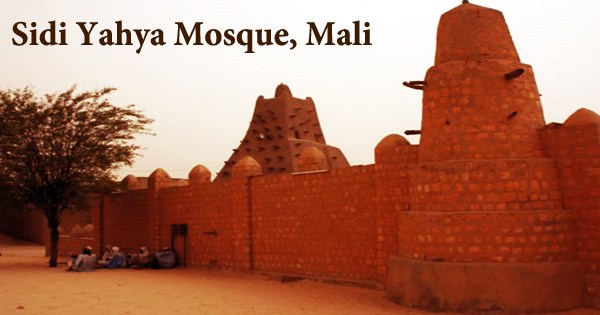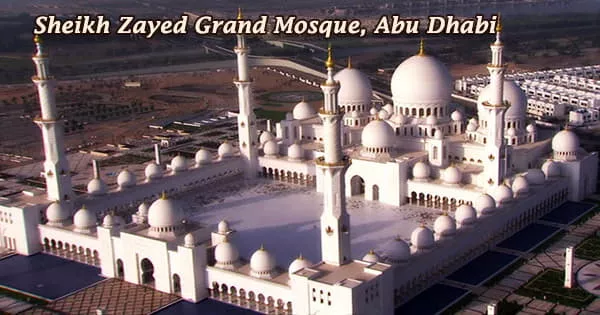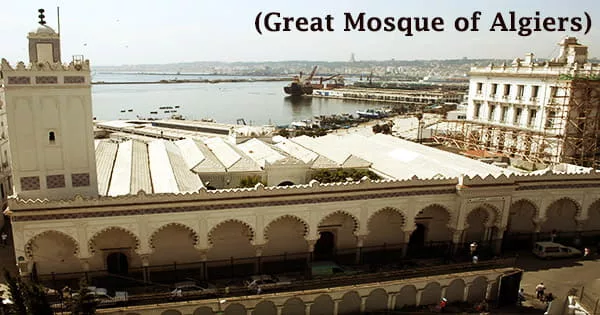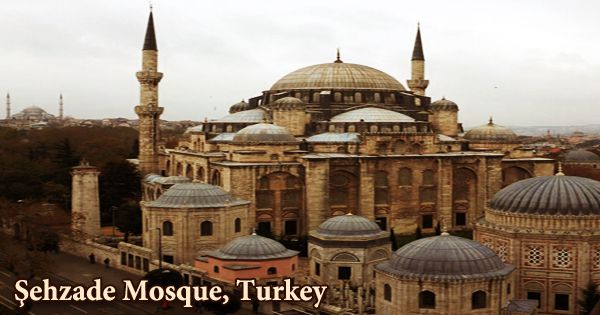The Mosque of Muhammad-n-Allah, also known as the Sidi Yahya Mosque (French: Mosquée de Sidi Yahya, Arabic: جامع سيدي يحيى), is a mosque and madrassa in Timbuktu, Mali. The mosque is located south of the Sankoré Mosque, which is more well-known. Sheikh El-Mokhtar Hamalla began construction on the mosque in 1400 A.D. in anticipation of a great holy person. It took 40 years for the project to be completed. The city-governor of Timbuktu, Mohamed Naddah, chose his close friend Sidi Yahya as the city’s first imam in 1441. This was the start of the mosque’s role as a madrassa and a major learning institution for the region. The madrasas of Sidi Yahya, Djinguereber, and Sankore are part of the University of Timbuktu, which also includes the mosque. The mosque is a typical example of Sudano-Sahelian earthen architecture, but it also has its own peculiar plan and adornment. One of West Africa’s oldest mosques. Between 30 June and 11 July 2012, a series of attacks targeting a number of religious landmarks in Timbuktu, including several prominent mausoleums, reportedly damaged the mosque’s door and smashed the tom of Sidi Yahya. The Sidi Yahya Mosque is one of Timbuktu’s earliest mosques, and it has a special significance: when the Touareg, led by Akil, conquered Timbuktu in 1433, they awarded the chieftaincy to Mohammed Naddi, a Senhaja from Chinguetti, who commissioned the mosque. The establishment of a madrassa in Sidi Yahya allowed for a tremendous expansion of knowledge sharing in Mali. Between 1468 and 1583, little is known about the mosque and its imams, except that it was renovated in 1569 by Qadi el-Aqib. The Mali government requested that the city of Timbuktu be included to UNESCO’s list of World Heritage in Danger in 1990, citing the threat of sand encroachment on historic buildings such as the Sidi Yahya Mosque. While the community has kept Sidi Yahya in better condition than Timbuktu’s other two main mosques, the edifice has been threatened by years of erosion, foundation degradation, and inefficient drainage. Timbuktu was removed from the list in 2005 after adopting and implementing recommendations for protecting its architecture from the organization.
Ansar Dine members knocked down the doors of the mosque in the summer of 2012, which were supposed to be closed until the end of the world, according to folklore. They argued that the devotion for the place was idolatrous, but offered to rebuild the mosque for only $100 US dollars. Cadi Al Akib renovated Sidi Yahya Mosque in 1577 or 1578. In 1939, its initial design was changed to make it look less like a military fortification. The original minaret, on the other hand, is still standing. The sepulchers of Sidi Yahya and Mohamed Naddah, who died one week apart, are beneath it. The earthen construction is totally built of natural and indigenous materials. Every year because of rain and erosion, the community partakes in a festival in which the banco, or mud mixture, is reapplied to the building. The mosque’s facade is studded with exposed wood beams known as torons, which are used to climb to the upper levels of the mosque to apply a new layer of mud. The style of the Sidi Yahya Mosque, according to Prussin Labelle, deviates little from conventional Islamic architecture’s focus on cosmology. The primary goals of medieval African socio-political organizations were permanence and monumentality, and this permanence is said to be represented in the earth-based architectural styles utilized to build the Sidi Yahya Mosque. A covered prayer hall, interior courtyards, wooden doors, and arched arches are among the architectural features of the structure. A solitary minaret with pointed arches rises over the mosque and main courtyard, but it is not as tall as the city’s other two big mosques. The courtyard was later turned into a cemetery, which is now defunct. The mosque’s imams are buried in an underground location to the north of the structure, where evening and morning prayers are said. It also contains lodgings for the mosque’s guard. The sacred gate, also known as the “secret gate of Sidi Yahia,” is unusual in size and significance because it is the sole gate of the mosque that faces the setting sun. The gate provides symbolic security to the mausoleums of Mohamed Nadhi, the town’s first chief, and Sidi Yahia, which are located in the courtyard that is the final resting place of a number of the town’s important figures. Traditional belief holds that whoever opens or breaks the gate would bring catastrophe to the city.
















